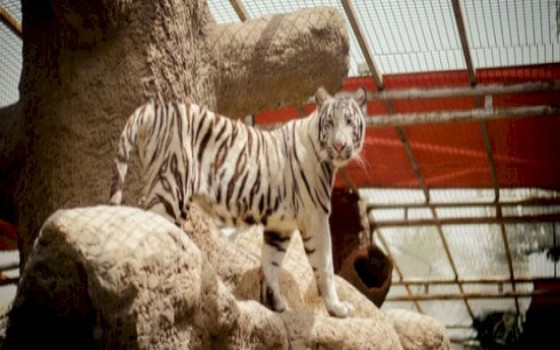
International Day for the Arabian Leopard.. to remind of its importance and to protect it from extinction.. it lives in the Gulf countries, Jordan and Morocco

- Europe and Arabs
- Thursday , 15 June 2023 12:39 PM GMT
Brussels: Europe and the Arabs
The United Nations General Assembly adopted a resolution declaring February 10 of each year the International Day of the Arabian Leopard, "given its vital importance to the ecosystem (environmental) in the Arabian Peninsula." According to Namaja in the United Nations news bulletin, a copy of which we received at dawn today.
The General Assembly resolution stated that the Arabian leopard is one of 9 species of tigers recognized by the International Union for Conservation of Nature, and that it is "the smallest, most distinctive and critically endangered subspecies of tigers."
The decision stated that the rapid disappearance of the Arabian leopard from large areas where it was previously found in the Arabian Peninsula represents a major setback in preserving biological diversity and achieving sustainability in the region.
The United Nations General Assembly welcomed regional initiatives for cooperation between countries sharing the range of wildlife and natural resources.
In the resolution, I stated that the greatest threats to the survival of the Arabian leopard are habitat loss and fragmentation, prey depletion and illegal trade.
She referred to the animal species in the Arabian Peninsula listed on the so-called Red List of Endangered Species, issued by the International Union for Conservation of Nature.
These animal species are: Arabian leopard, hawksbill sea turtle, whale shark, Arabian oryx and rhinoceros.
The UN resolution emphasized the importance of these organisms to the ecosystem and their role in maintaining its balance.
The General Assembly stressed the urgent need to address the unprecedented global decline in biodiversity, including through the protection of endangered species and the preservation of ecosystems.
The draft resolution was submitted by 12 countries: Jordan, the United Arab Emirates, Bahrain, Oman, Qatar, Kuwait, Morocco, Saudi Arabia, Mauritania, Yemen, Azerbaijan and Kazakhstan.
The Arabian tiger is a carnivorous (meat-eating) mammal that belongs to the feline family. It is a subspecies of the tiger native to the Arabian Peninsula, which today includes southern Syria, Palestine, Saudi Arabia, the Emirates, Yemen, and Oman. It is one of the subspecies of tigers. The Arabian leopard is considered the largest and most powerful species of Arabian cat, but it remains the smallest in size among all tiger subspecies, which spread in the continents of Asia and Africa, and it has been listed as endangered on the IUCN Red List since 1996, when it was estimated that less than 200 wild individuals are alive. Life in 2006. It is believed that their number is constantly decreasing.
Arabian tigers are animals that live in high mountains, in contrast to what the public thinks that they are animals that inhabit the desert and the jungle areas that dominate the countries that inhabit them. They are mainly found in Jabal Samhan in the Omani Governorate of Dhofar, the two mountain regions of Al-Baha and Asir, and the Shada Mountains in Al-Makhwah in southern Saudi Arabia and in the Ain Gedi Reserve. Near the Dead Sea in Palestine. Arabian tigers feed on Nubian ibex, wild goats, Arabian tahr, foxes, and other mountain animals. Each tiger owns its own territory and defends it against other tigers of the same sex. The male area is larger than the female area and always intersects with multiple female areas. Within these areas, tigers hunt, mate, and raise their cubs. Tigers to expand their search for food, and this also indicates that Arabian tigers were never abundant in such areas.
The Arabian leopard is characterized by its activity day and night, but it remains wary of human presence, and these solitary animals do not meet other tigers except during the mating period, which lasts approximately 5 days, during which they mate several times. After a gestation period that lasts between 98 and 100 days, the female gives birth to one to four cubs in a cave or rocky crevice. The cubs are blind at birth, and their eyes open after nine to ten days, when they begin to explore their surroundings. They usually do not leave the den on their own until they are at least four weeks old. During these first weeks, the mother moves the cubs from one den to another several times to reduce the chances of other predators finding them. The age of tigers in the wild ranges from 10 to 15 years, while their age in zoos reaches 52 years.
The Arabian tigers are very light in color, as the yellowish-golden color, which is usually found between spots in most parts of the body of the rest of the subspecies, is not present in this subspecies except along its back, and then fades to pale yellow or white on the rest of the body. It is distinguished by the color of its blue eyes, unlike its African counterparts. The adult female weighs 20 kilograms (45 lbs), while the adult male weighs approximately 30 kilograms (65 lbs). In comparison, the South African tigers can range in weight from 50 to 70 kilograms, and thus the Arabian tigers can be considered smaller than the rest of the African and Asian tiger subspecies. The male is similar to the female, but the males are larger than the females, and they are distinguished by the presence of a clear scrotum in the males, and the Arabian tigers are distinguished by their long tails, which they use for balance while climbing.












No Comments Found